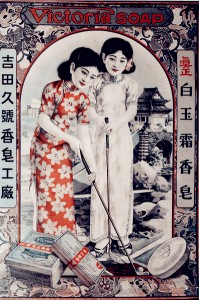
Two women wearing cheongsam in a 1930s Shanghai advertisement.
The cheongsam or qipao has been present in China’s fashion scene for centuries. Although it became muted post 1930’s, leading cultural authorities including world renowned fashion designers, like Oscar de La Renta and Valentino, as well as Chinese art, film and television resurrected the qipao from an article of service wear to a product of high end fashion in the early to late 1990s. Although the qipao has persisted throughout history, it is important to recognize that the meaning of the qipao has never been static. The qipao holds distinct cultural, social, and symbolic values unique to each of its various time periods.
The image above is an advertisement for Victorian Soap and was published in 1930’s Shanghai. At the center of the photo are two young women. The backdrop is a traditional Chinese garden. One woman wears a red and white floral printed qipao while the other’s is black and white. The two girls have short western hair styles and shoes as well as red lipstick. Both are also holding golf clubs. The women on the left prepares to swing. Around the image is a floral border with inscriptions lining the sides. In the foreground are enlarged versions of the Victorian Soaps advertised. need a thesis statement right here
This advertisement is a classic example of the type of photo calendars typically distributed during this era. In the 1930s, the urban center of Shanghai was the metropolitan capital of China. When situated in its unique historical context, we can understand the picture of the two females as representative of the newly gained independence women had found in the public landscape at the time. The fact that the women are depicted outside in a garden landscape signals to this new sense of freedom. The two women are also holding golf clubs. Previously sports and outdoor activities traditionally reserved for men, like golfing, began to allow female participants in the 1930s.
Western influence from the ongoing colonial era is also signified by their bob hairstyle and red lipstick. Instead of the bound feet of the previous era, the women have natural feet adorned with western style shoes that were more practice for outdoor activities. Although the long qipao’s have traditional floral patterns popular at the time, their short sleeves make them much more revealing that the conservative dress of the 1920’s. In order to make the clothing distinctly feminine, the qipao’s are form fitted. Before, the qipao was seen as a distinctly male form of dress because of its rather shapeless figure. By this time however, western fitted elements were added to emphasis sexuality and gender norms.
Although central to the poster, the advertisement is not for the qipao but rather for Victorian Soap. By associating the two however, it connotes to the viewer that the stylish and modern Chinese woman is a consumer of this product. In a way, this type of association works to sell not only the soap but the women. If one uses the soap, they too can achieve the sense of sexuality and modernity portrayed in the picture. Although the women in the poster are shown enjoying new social independence, their highly sexualized depiction as well as the manor in which they are sold beside the product, reminds us of that despite the era’s progress, the patriarchy and its objectification of women still dominates.
the thesis came finally at the end of your post, which could be introduced at the beginning
